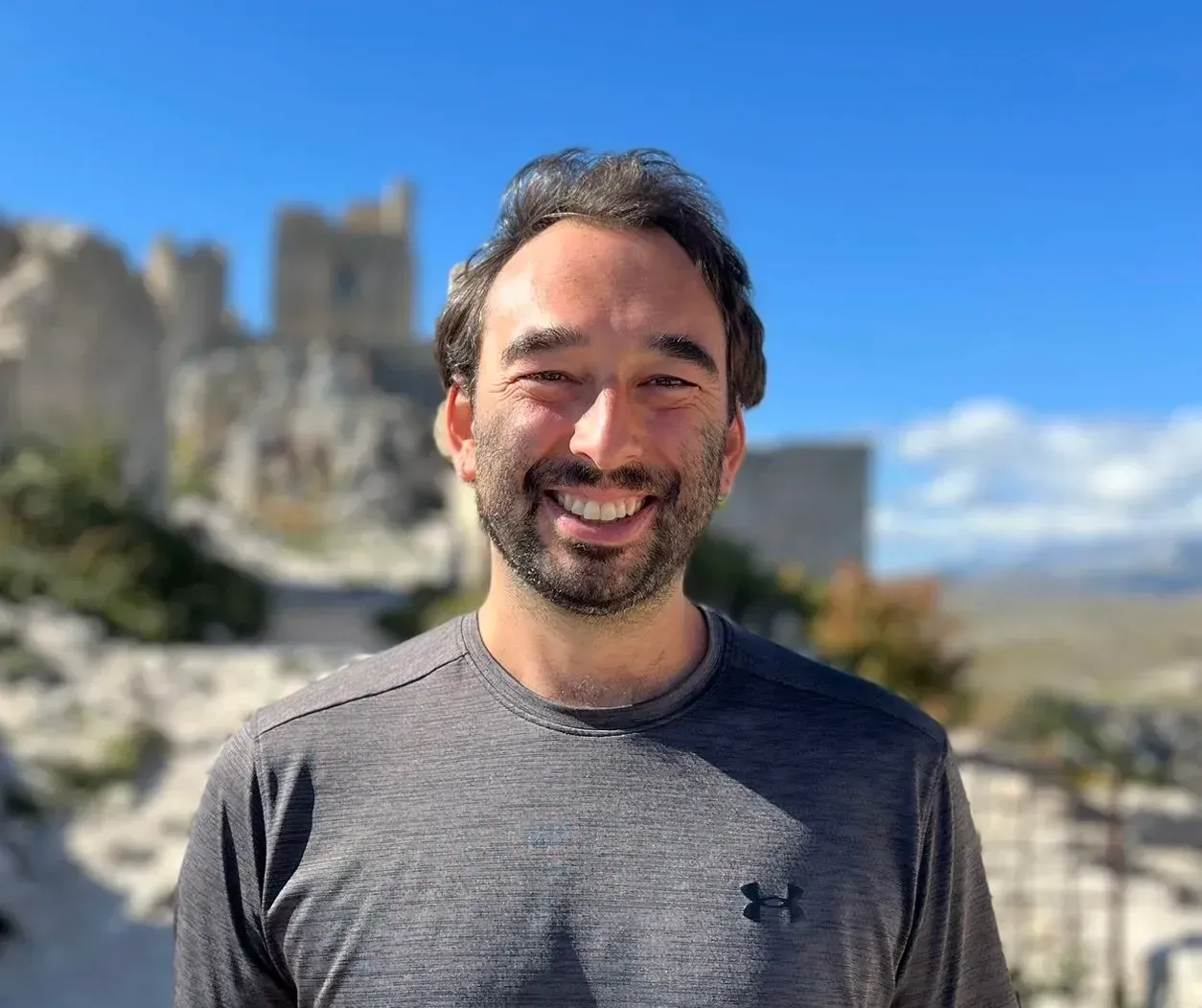
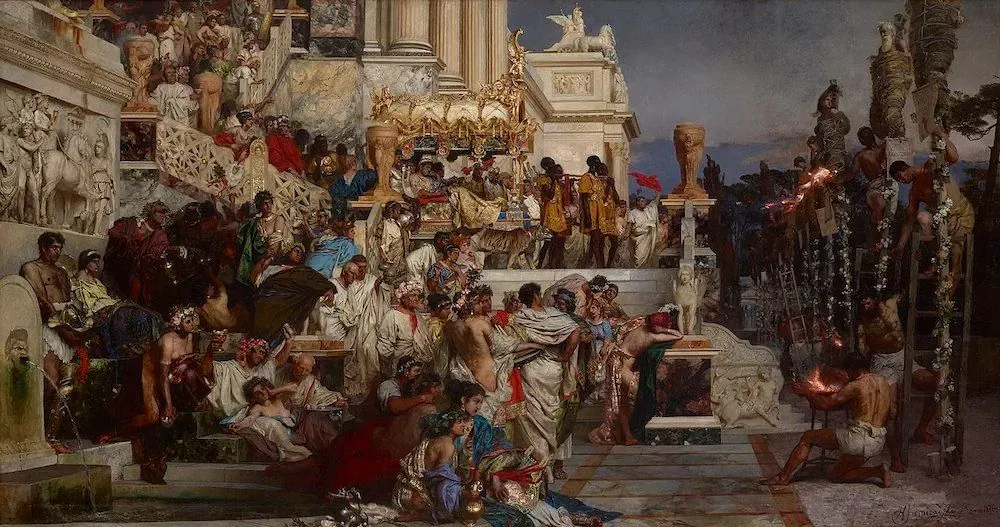


Roman emperors have a bad press in the popular imagination. Their reputation for cruelty, excess, and debauchery, enabled by unbridled power at the head of a decadent society, still serves as a warning against the pitfalls of absolute power, and people draw lessons from their lives in defence of democracy. Figures like Caligula, Nero, and — thanks to Ridley Scott's Gladiator—Commodus have become household names and bywords for depravity. But how deserved is the reputation of the Roman emperor?
Testament to how bad (or at least unpopular) many Roman emperors were was their incredibly short lifespan after ascending to the throne. Of the 69 emperors from the accession of Augustus and the reign of Theodosius, a staggering 62% suffered a violent death. So who were the worst Roman emperors? Where does the fact become fiction? And which traces (if any) of these megalomaniacal men survive in the modern city of Rome?
As Rome’s second emperor (reigned 14 - 37 CE) after the empire was founded by Augustus, Tiberius had a lot to live up to. Augustus had found the perfect balance of executing one-man rule while pretending the Senate still held all the power. He brought peace to Rome after nearly 100 years of civil war, and enriched the city beyond recognition through a series of military conquests in Spain, Croatia, and modern-day Macedonia.
When Augustus died peacefully in his bed at the age of 75, he left no successors. And so the throne passed to Tiberius, his adopted son - the offspring of his wife Livia, and her first husband.
Tiberius was an excellent soldier, but never wanted to become emperor. Instead, he was forced onto the throne through the machinations of his mother, who if our sources are to be believed, poisoned every other potential successor to secure her son’s promotion.
One reason Tiberius was such a bad emperor is that he spent as little time in Rome as possible.
In 26 CE, Tiberius retreated to the island of Capri off the coast of Naples, never to return to Rome. He promoted a man called Sejanus, the head of his Praetorian Guard, to effectively administer the Empire in his absence, and for the next five years Sejanus purged the Senate and imperial family of all potential threats. But a failed conspiracy five years later saw Sejanus' fall from grace and swift execution, and his corpse unceremoniously thrown down Rome’s Germonian Stairs.
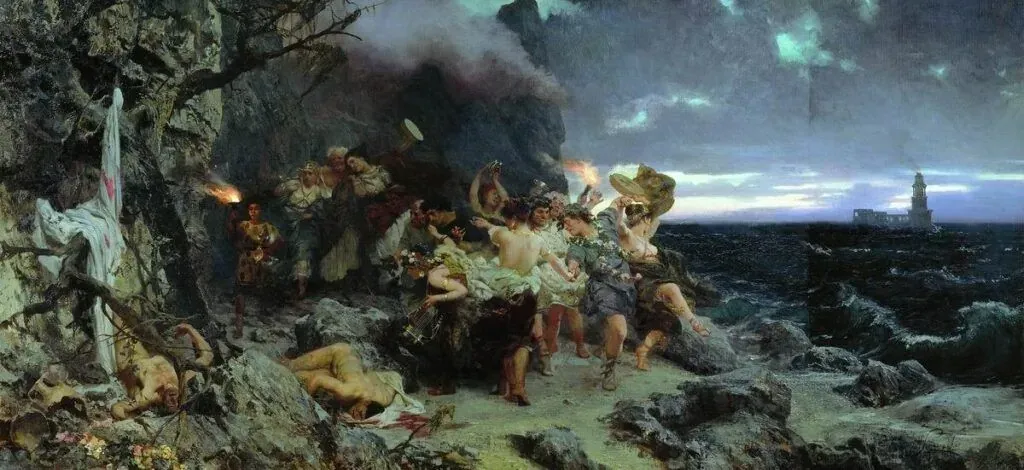
Orgy from the times of Tiberius on Capri by Henryk Siemiradzki (1881)
Tiberius remained on Capri, where he indulged in the most perverse of pleasures. His imperial biographer, Suetonius, accuses him of unchecked bloodlust and all sorts of sexual depravity involving prostitutes and even infants. He murdered anyone who posed a threat, including the entire family of his great-nephew, Caligula. He even kept Caligula hostage on Capri, privy to the pornographic perversions in which Tiberius indulged.
The official version relates that Tiberius died of natural causes. However, there were rumours that Caligula conspired with Macro, the head of the Praetorian Guards, to have Tiberius poisoned over a prolonged period.
In one version of events, Macro smothered Tiberius with his own bedsheets. In another, Tiberius managed to get up from his deathbed but collapsed at once and was pronounced dead.
If the Senate weren’t fans of Tiberius, the people hated him even more. According to Suetonius, upon hearing news of his death the people ran around Rome chanting “into the Tiber with Tiberius”. Alas his body was not cast into the river, but cremated and placed in an urn in the dynastic Mausoleum of Augustus which you can still visit today.
Caligula (37 - 41 CE) has entered the annals of history as one of the worst emperors of the Roman Empire. During his short but chaotic reign, he wreaked havoc among the Roman elite, demanding senators worship him as a god, brazenly taking their wives as concubines, and ordering the arbitrary executions of all those he mistrusted.
Caligula executed his teenage co-ruler, Tiberius Gemellus, for the audacious crime of drinking an antidote to protect himself from poison. Such was Caligula’s hatred for the Senate that he joked about making his horse a consul (Rome’s most senior office) rather than offer the role to one of them.
When Caligula came to power, the Romans hailed him as their golden prince. His father, Germanicus, had been a darling of the Roman military, winning a string of military victories against the marauding German tribes, and his mother, Agrippina the Elder, had been a model of Roman virtue. Both were brought down by the machinations of Tiberius: Germanicus was poisoned in Antioch, Syria, in 19 CE while Agrippina was later starved to death in prison on the Italian island of Pandateria.
Caligula spent his teenage years as the emperor Tiberius’ hostage on the island of Capri. Unable to mourn his parents or siblings, his only chance of survival was to sweeten up to the emperor — to participate in his perversions and act as if he posed no threat. One of the most famous sayings we have about Caligula refers to his talent for dissimulation: “Never was there a better servant or a worse master.”
Just four years into his reign, at the age of just 29, Caligula was hacked to pieces on his way out of the theatre. Assassinated by disgruntled senators under the leadership of the Praetorian Prefect. All held personal grievances against him, not least the Praetorian Prefect, Cassius Chaerea, who Caligula routinely mocked for his apparent effeminacy.
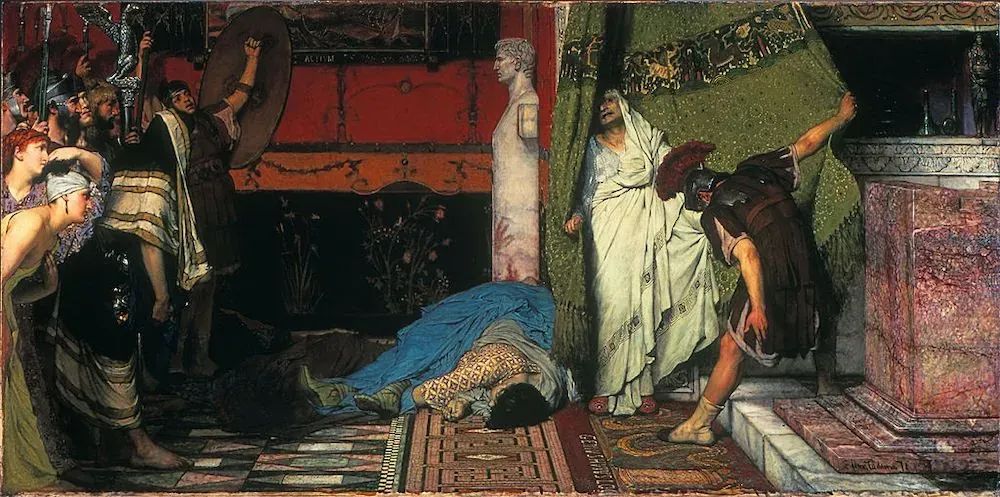
A Roman Emperor by Sir Lawrence Alma-Tadema (1871). Caligula's corpse is splayed out on the floor while his successor, Claudius, hides behind a curtain.
The conspirators cut Caligula’s genitals off, and to put an end to his Julian bloodline they butchered his wife and infant daughter. His wife, Milonia Caesonia, was hacked to death beside him while his daughter was taken out of sight and dashed against a wall.
Later writers tried to justify the murder of his one-year-old daughter Julia Drusilla by saying she’d inherited her father’s savagery and would bite and scratch at the faces of those who played with her. But it’s patent that this was no more than desperate propaganda to justify the barbaric murder of an infant.
It’s for good reason that Nero is the most infamous of all Roman emperors. Ascending to the throne in 54 CE at the age of just 16, his 14-year reign was marked by a string of scandals, excesses, and atrocities — not to mention the murder of his mother (and Caligula’s sister) Agrippina the Younger.
Nero’s most notorious act was the Great Fire of Rome in 64 AD, which he is rumoured to have started himself in order to clear space for his grandiose building projects. In the aftermath of the fire, Nero did in fact set about constructing a grand luxurious palace for himself known as the Domus Aurea (Golden Palace), parts of which you can visit today. And stretching out in front of the palace was a large artificial lake, which was drained after Nero's death to serve as the foundations for the Colosseum.
However, there’s compelling evidence that Nero was not involved in the fire: not only was he at Anzio while the fire broke out, but he rushed back to Rome as soon as possible to help extinguish the blaze and open up his gardens to those made destitute.
One thing that is beyond doubt about Nero is that he was notorious for his persecution of the Christians, whom he blamed for starting the fire. Saint Peter was executed under Nero’s reign, crucified upside down in Nero’s Circus which is now beneath the Vatican, and Saint Paul was beheaded in 64 CE and later interred beneath the present site of the Basilica of Saint Paul outside the Walls.

Nero's Torches, by Henryk Siemiradzki (1876). According to Tacitus, Nero used Christians as human torches
But fewer suffered more than his own family members.
Ultimately, Nero's reign ended in his suicide in 68 AD. It was to mark the beginning of a period of intense civil war, known as the Year of the Four Emperors.
Learn all about Nero’s debauchery on our Rome Tipsy Tour
Few Roman emperors have such a damning reputation as Domitian (81 – 96 AD). Domitian comes down to us as the worst emperor of the Flavian dynasty; a cruel, ruthless autocrat, and a powerful, paranoid psychopath who purged the Senate and impregnated – and then murdered – his niece.
Such was Domitian’s sadism that one of his favourite alleged pastimes was to stab flies with a stylus (sharp pen) before plucking their wings out one by one.
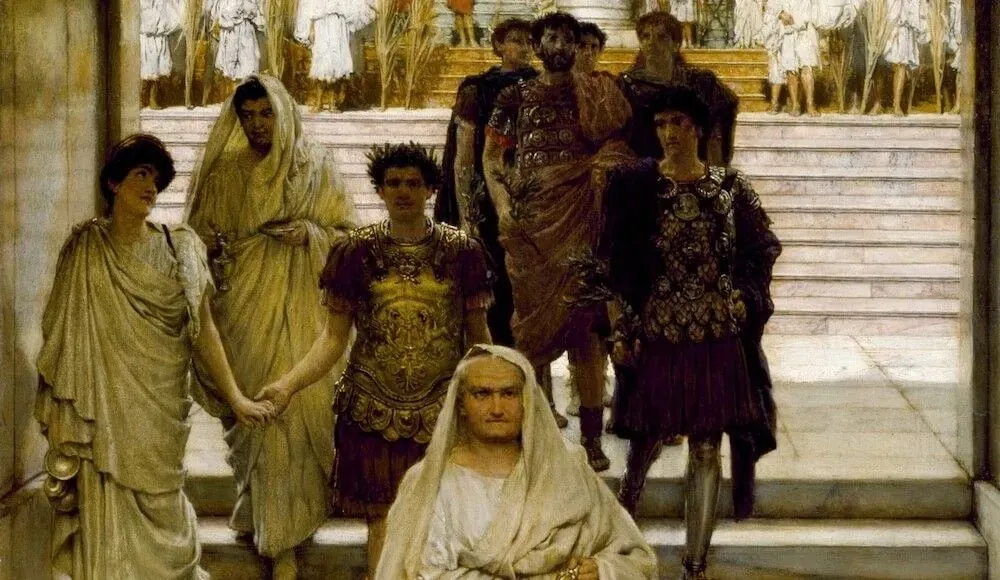
The Triumph of Titus by Sir Lawrence Alma-Tadema (1885)
Domitian was the younger brother of the more successful emperor Titus, and he inherited the throne in 81 AD. However, his rule was marked by paranoia, cruelty, and extravagance. He was notorious for his purges of the aristocracy, whom he saw as a threat to his power, and for his persecution of philosophers and other intellectuals. He also built grandiose monuments and held lavish games and spectacles, which drained the treasury and alienated the populace. Domitian's reign came to an end in 96 AD when he was assassinated by members of his own court.
.webp)
Domitian's Obelisk in the centre of Piazza Navona
Domitian might have terrorised the Roman Senate, but he left plenty for the Roman people. You can still visit his stadium underneath Piazza Navona and see the obelisk he brought to Rome embedded in Bernini’s Fountain of the Four Rivers.
Caracalla came to the throne in February 211 CE alongside his younger brother, Geta. By December that year, Geta was dead and Caracalla ruled alone, the head of a regime marked by instability, violence, and bloodshed. But even Caracalla could not hold onto power for long, and by 217 CE he too was dead, slaughtered by his Praetorian Prefect in Parthia while urinating by the roadside.
Caracalla and Geta inherited the throne from their father, Septimius Severus, whose triumphal arch still stands at the northwestern end of the Roman Forum. From the beginning of their joint reign, these brothers had a strained relationship. Their mutual mistrust meant that they always surrounded themselves with armed guards in case either brother made an attempt on the other.
But it was Caracalla who would ultimately prove the more devious.
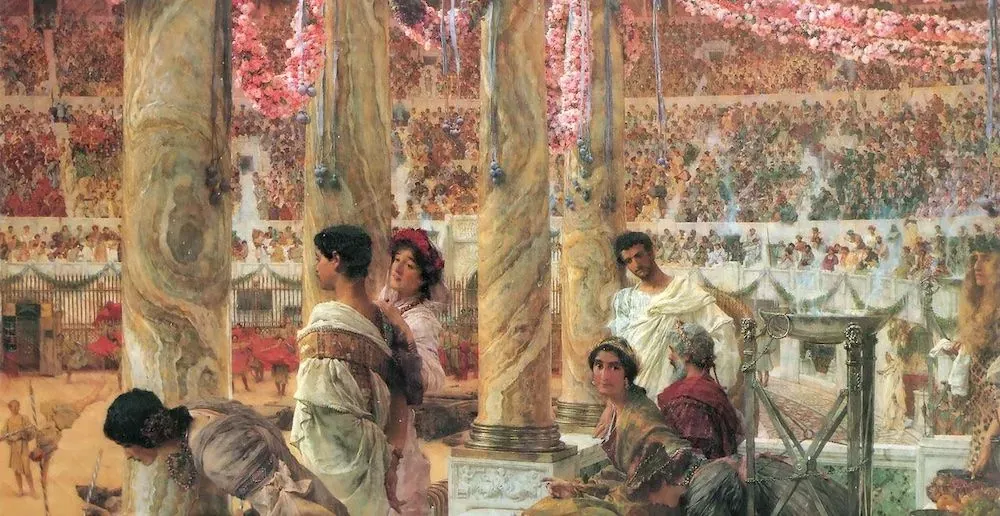
Caracalla and Geta by Sir Lawrence Alma Tadema, 1907
The historian Cassius Dio tells us that on December 26, 211, Caracalla asked their mother to organise a private meeting in her apartment so they could discuss a truce. Geta entered the apartment unaccompanied, as promised. But as he did the Guard Caracalla had posted outside rushed into the apartment and attacked him.
The scene Dio describes is tragic. Sensing his death, the 22-year-old Geta ran to his mother for protection. But she was unable to help, and in his helpless mother's arms, Geta was hacked to death beneath a flurry of blades.
Following this cold-blooded act of fratricide, Caracalla ordered for all possible traces of Geta to be destroyed. The Arch of the Moneylenders near Rome's Forum Boarium is one of the clearest examples of Geta’s damnatio memoriae - not just on the frieze but on the arch’s inscription. If you look at the top line, you can clearly see where his name has been removed in an attempt to erase any trace of his existence. But there are other examples too.
Many inscriptions and images of Geta were erased across the empire. His portraits were chiselled out. Even coins bearing his profile were removed from circulation and melted down. Caracalla was told that his crime could be mitigated if he could declare Geta a god and introduce him to the Pantheon of the imperial cult.
Caracalla’s response was chilling
“Let him be a god, provided he is dead.”
Elagabalus was a teenage emperor who ruled from 218 to 222 AD, and his reign was marked by scandal, excess, and sexual deviance. He was notorious for his worship of the sun god Elagabal, whom he brought to Rome and installed in a temple on the Capitoline Hill as Rome's main deity. Elagablus also flaunted his sexuality, marrying and divorcing multiple wives and engaging in same-sex relationships with both men and women.
Elagabalus is said to have engaged in shocking acts of sexual perversion, such as prostituting himself in the streets and forcing women to have sex with him in public. His reign ended in his assassination by the Praetorian Guard, who had grown tired of his excesses and instability.
Looking for something different in Rome? Join our Tipsy Tour!
This unique experience blends the best elements of travelling: sharing scandalous stories, learning the local history, and trying traditional drinks with fun-loving, like-minded travellers. Spaces are limited, so book now to avoid disappointment!

No headings found in content.
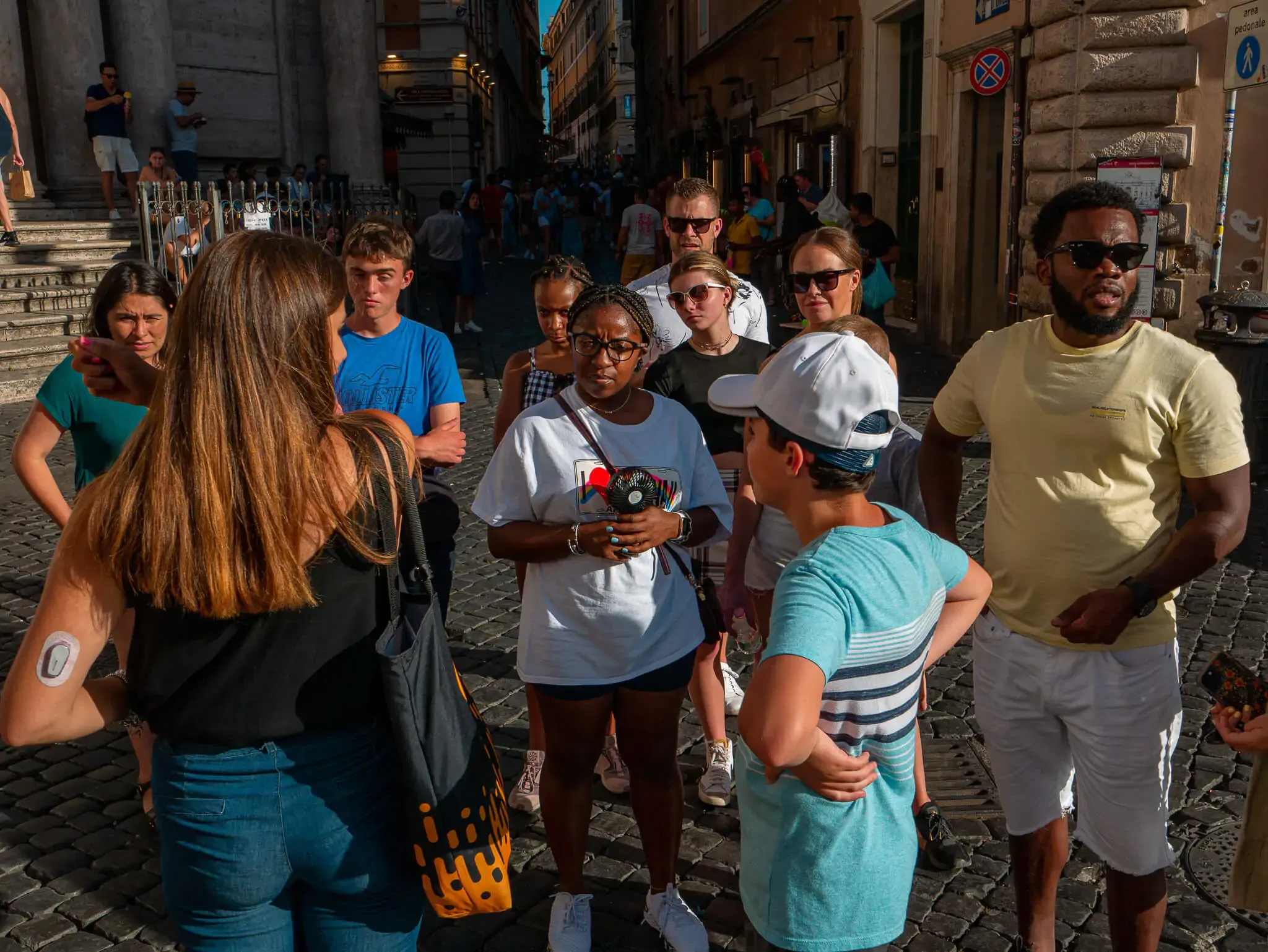
Explore the wonders of the Eternal City on our best of Rome walking tour. As you get your bearings around Rome’s cobbled historic centre, your expert storyteller will bring Rome’s most must-see sites to life, including the Pantheon, Trevi Fountain, and Piazza Navona. Take photos, make memories, and most importantly, get the most out of your time in the Italian capital!
Your private guide will share the city’s secrets and narrate its story in a way that will make you feel like you’ve stepped back in time – from explaining how the stunningly intricate churches and palaces were erected, to how the grand fountains were used to channel water throughout the city.
We will start at Trajan’s Column, which portrays the bloody victory of the emperor during the Dacian wars in Eastern Europe. We’ll then head to the Piazza Venezia, the crossroads between the ancient city and the modern capital and one of the most scenic squares in Italy!
After taking a moment to marvel at the imposing Altar of the Fatherland, we’ll make our way to the iconic Trevi Fountain. Toss a coin into the fountain, spend a moment soaking in its sounds and scenery (metaphorically, not literally!), and uncover the fascinating stories behind the fountain’s statues and symbols.
After discovering the incredible frescoes within the church of Sant Ignazio, we’ll make our way to the Pantheon where the spectacle of the 2000-year-old dome will blow you away. Marvel at one of the best-preserved buildings of the ancient world, hear the story behind the man who built it, and discover the shocking architectural secret behind how the dome is (or isn’t) supported!
Your private walking tour of Rome finishes at Piazza Navona. The square is situated near some of Rome’s best and most vibrant bars and restaurants and your guide will be happy to recommend where to go.
This tour is suitable for people of all ages and fitness levels. You can expect this memorable experience to last about two hours, which leaves you with more than enough time to explore the city beyond.
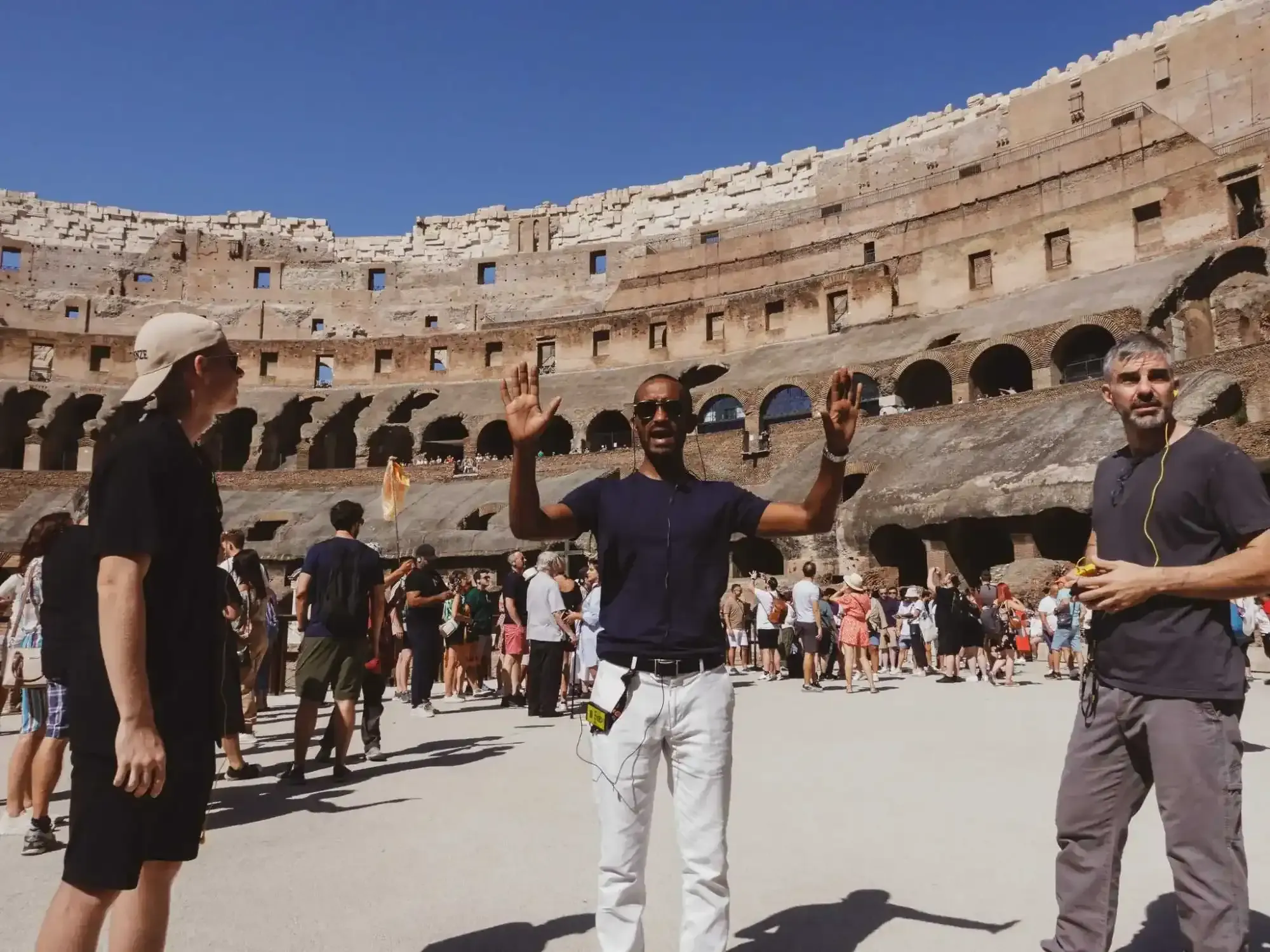
Channel your inner-Maximus as you step out onto the Colosseum Arena floor and access this recently reopened area of the world famous amphitheatre. Then, explore the rest of the heart of ancient Rome, with a friendly, expert guide and a small group of like-minded travellers!
Unlike regular tours of the Colosseum, our Colosseum Arena Tour gets you straight inside the ancient amphitheatre and out onto the arena floor through the Gladiator’s Gate. This is the route the gladiators themselves took almost 2,000 years ago. Imagine the moment they left the gates, and were greeted by the cheers and jeers of 50,000 bloodthirsty spectators.
Your expert guide will transport you back in time to the height of the Roman Empire when the Colosseum was constructed. These were times when Rome was ruled by all-powerful emperors (sometimes wise, sometimes wacky), the city was flooded with exotic riches from around the world, and the Colosseum acted as the city’s main stage for showing off the animals and people that Rome had conquered and captured.
After a short 30-minute break, we’ll head off on the next part of the tour…
Next, we’ll climb the Palatine Hill, where the ancient city was founded. The Palatine Hill is a real archaeological wonder, home to settlements from the Iron Age to the 16th century. Gaze upon such sites as the Hut of Romulus, Rome’s legendary founder, and the Imperial Palace, where the emperors in their family engaged in ruling, politicking, and scheming. Get your camera at the ready – you really can’t beat these views!
The final destination on our Colosseum Arena Tour is the Roman Forum. As the beating heart of ancient Rome, the Roman Forum was once a bustling hub of markets, law courts, temples, and more. It was here that Julius Caesar was cremated, where victorious triumphs paraded with the spoils of Roman conquests, here where two disgraced emperors were murdered in 69 AD, and here where Cicero delivered the speeches that shaped western culture for centuries.
When our tour is over, feel free to stay and explore the Roman Forum at your own pace.
Book the complete ancient Roman experience today with our Colosseum Arena Tour!
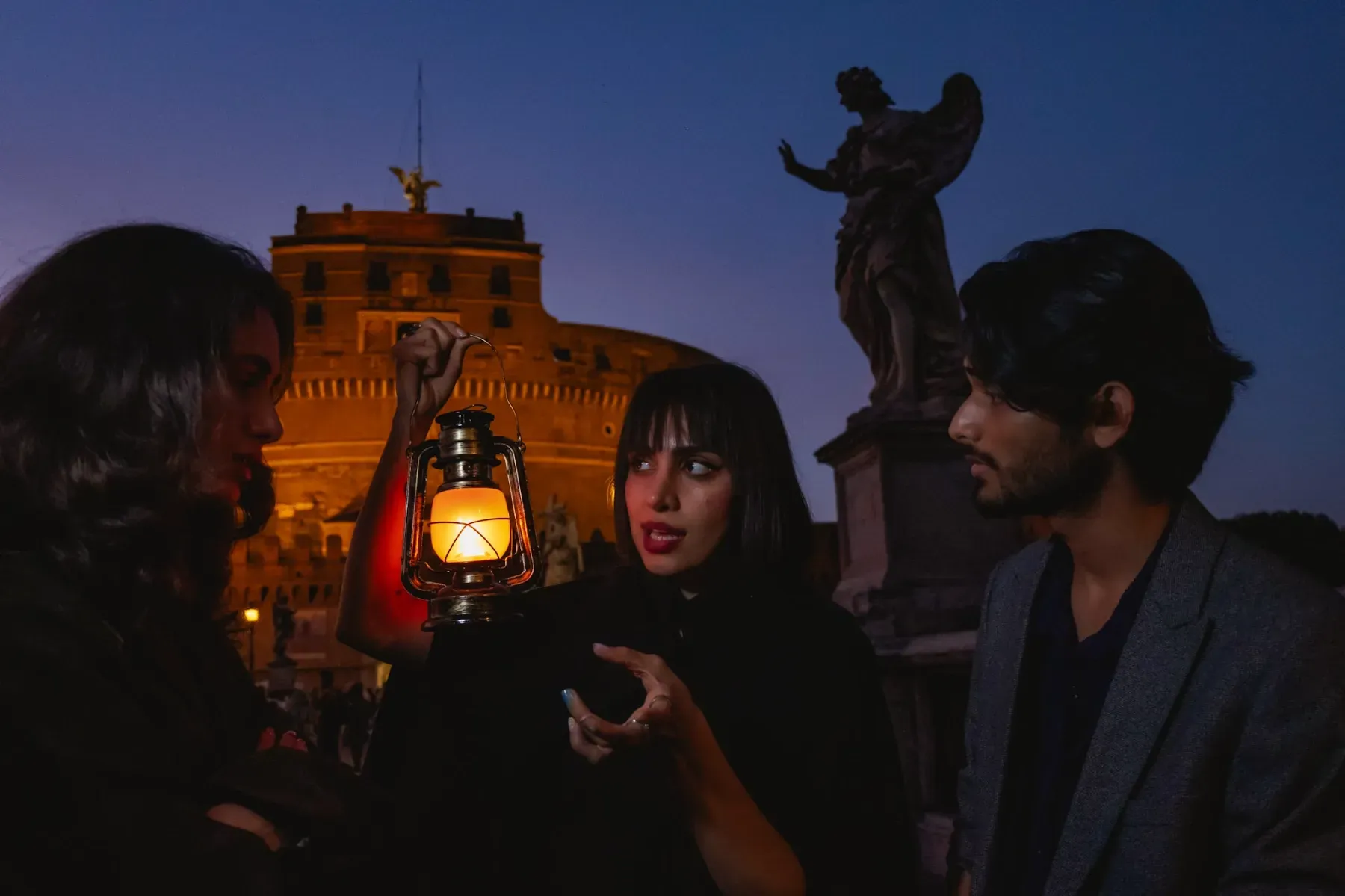
Rome may well be the world’s most beautiful city, but after dark a more sinister side emerges. The ghosts of popes, emperors, and artists lurk on every corner, their lives claimed by tragedy and conspiracy across more than 2,000 years of history. Our Rome Ghost Tour is not for the faint hearted — you’ll hear the ghastly tales of beheadings and murder that are sure to keep you up late at night.
Your Rome Ghost Tour starts at Campo de’ Fiori, a central square, where you’ll be treated to the tale of Giordano Bruno, one of Rome’s greatest minds who got on the wrong side of the church. After learning about his grisly end, you’ll begin to explore the city. Venture through medieval backstreets; visit an ancient church adorned with skulls; and step inside the home to a mysterious order of monks. Discover the childhood home of one of Rome’s most infamous executioners; see the site of one of Rome’s most infamous prisons; and pass by a poisonous perfumery where cosmetics killed.
Your tour ends at the imposing Castel Sant’Angelo, where your guide will reveal the horror of Rome’s most disturbing executions. If you’re (un)lucky, you might even encounter a ghost or two.
No matter what, you’ll never see Rome the same way again.
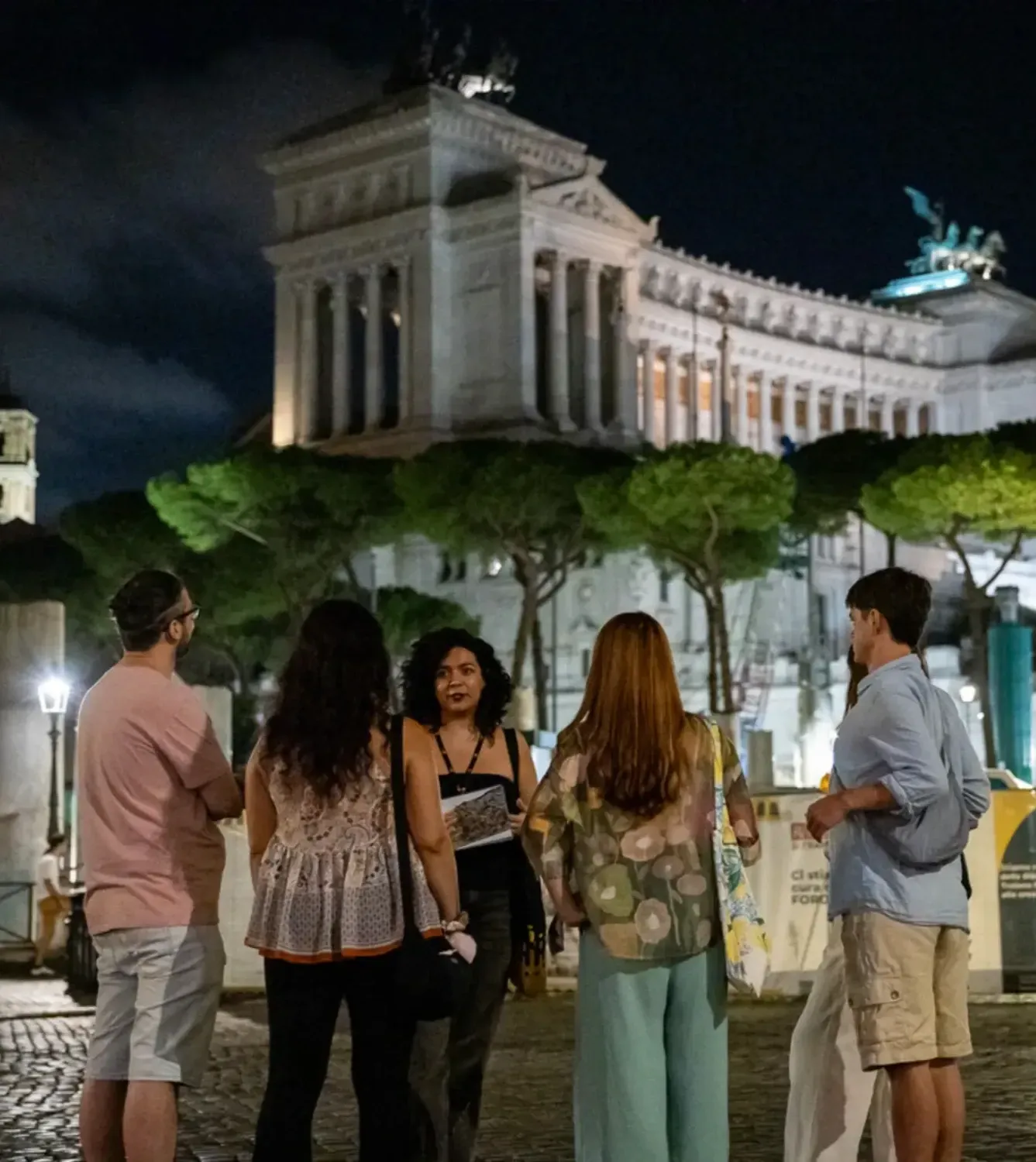
Join us on a journey through Roman history on our immersive Rome by Night Walking Tour. Your expert guide will share the city’s secrets, history, and fascinating tales—from antiquity through to the modern day, and at a pace to suit you.
Our tour starts in Rome’s most picturesque square, Piazza Navona, where the ancient Romans used to watch athletic contests (agones). Today’s piazza sits above the ancient stadium and boasts Gian Lorenzo Bernini‘s stunning Fountain of the Four Rivers as its centrepiece.
A five-minute walk from Piazza Navona takes us to the world-famous Pantheon. Constructed more than two-thousand years ago by the eccentric emperor Hadrian, the Pantheon was consecrated as a monument to all the pagan gods (pan theos, in Greek meaning all the gods). This second-century temple is one of the best-preserved monuments in the Roman Empire and its unreinforced concrete dome still perplexes architects.
Our next stop is the iconic Trevi Fountain. Immortalised by Anita Ekberg wading through its water in Federico Fellini’s iconic film La Dolce Vita, the Trevi Fountain one of the most romantic spots in the Eternal City. Snap your photos of the monument in the moonlight, listen to your guide decipher its symbols, and toss a coin over your shoulder to guarantee your return to Rome.
We emerge from Rome’s winding backstreets onto Piazza Venezia. Stretching from the foot of the Capitoline Hill, against the backdrop of the Altar of the Fatherland, Piazza Venezia is Rome’s most recognisable square, and a repository of history involving figures from Napoleon to Mussolini.
Your guide will lead you down the Via dei Fori Imperiali, the boulevard that cuts through ancient Rome, past Trajan’s Column and alongside the forums of Trajan, Augustus and Nerva. Your guide will feed your curiosity and nourish you with knowledge about ancient Rome and its empire as you make your way towards the most famous monument of all: the Colosseum.
The Colosseum is one of the most awe-inspiring attractions that has survived from antiquity. As a colossal feat of architecture and engineering, its form has been replicated throughout the ages, manifested in stadiums and sports venues around the world. But while its form is familiar to us, the spectacles it accommodated are entirely alien, and remind us of the violent nature of Roman culture.
Group sizes are 15 people maximum.
Book your spot now to avoid missing out!
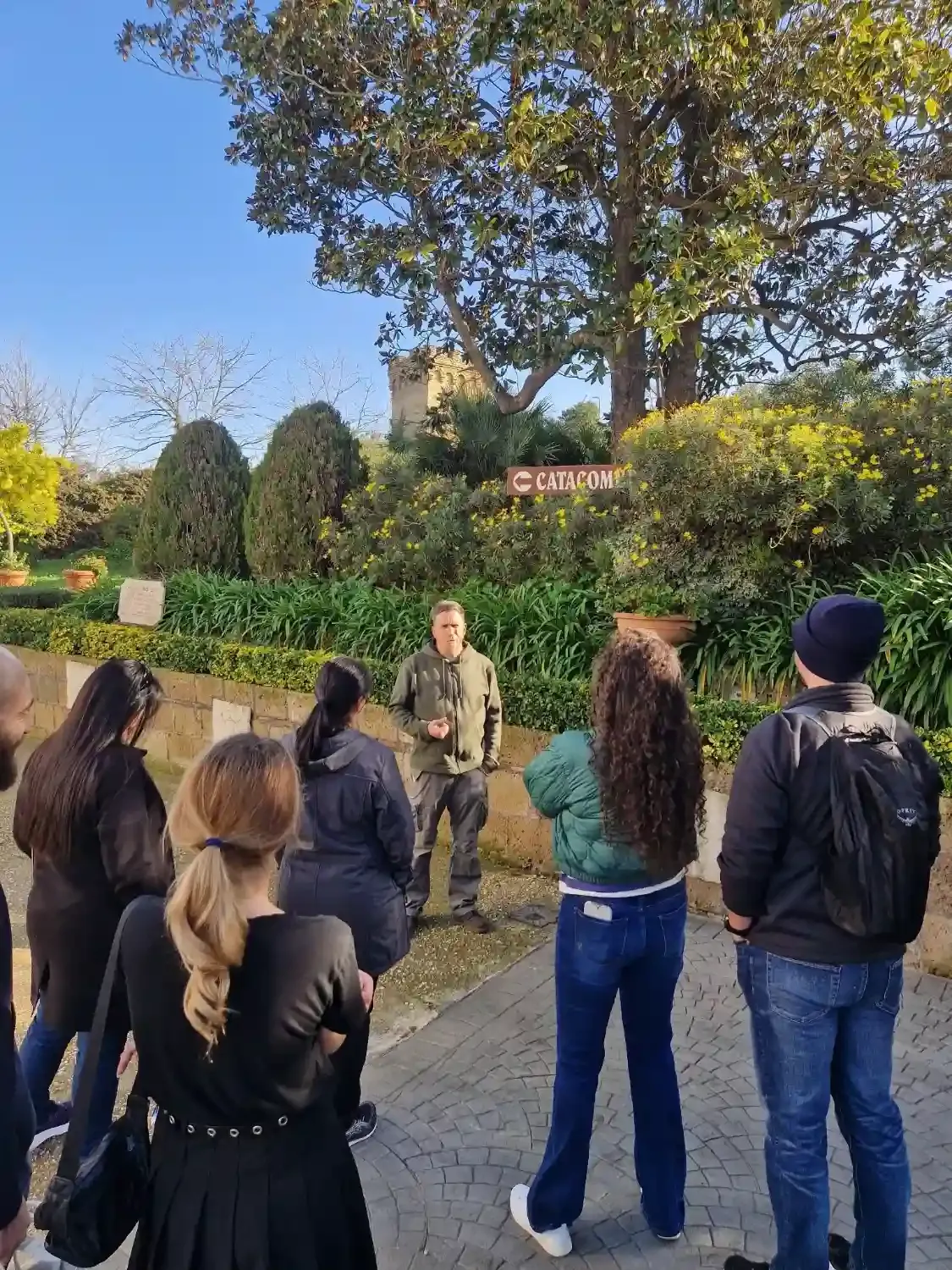
The best way to understand Rome is to take a look beneath it. Our Rome Catacombs Tour is perfect for travellers who want to get off the beaten track, unearth underground passageways, and discover the secrets of the largest catacombs in Rome.
Prepare to discover the deeper, darker, and more mysterious parts of Roman history with a small group of like-minded adventurers. By digging downwards into the ancient labyrinth of tunnels, we’ll uncover all the secrets and dark tales of the catacombs of Domitilla.
Your friendly expert guide will meet you outside and give you a quick overview of the tour before we make our descent. With our close guidance, you’ll have the chance to explore and discover ancient passageways in the largest, most famous catacombs in Rome. These tunnels are sacred and an integral part of the Christian and Roman faiths. Learn how ancient Christian rites and rituals were held underneath the bustling city streets.
These tunnels were not only a place of ritual, but are still a sacred place of rest for more than 150,000 bodies. These catacombs and the bodies they hold stretch for almost 20 km underground, some of which is yet to be seen by the public eye.
With a maximum of ten travellers per tour group, you’ll have the opportunity to ask plenty of questions. The price of the tour includes the tickets. If you’d like to join us on our Rome Catacombs Tour of the darkest, largest catacombs in Rome, book your spot now to make sure you don’t miss out!
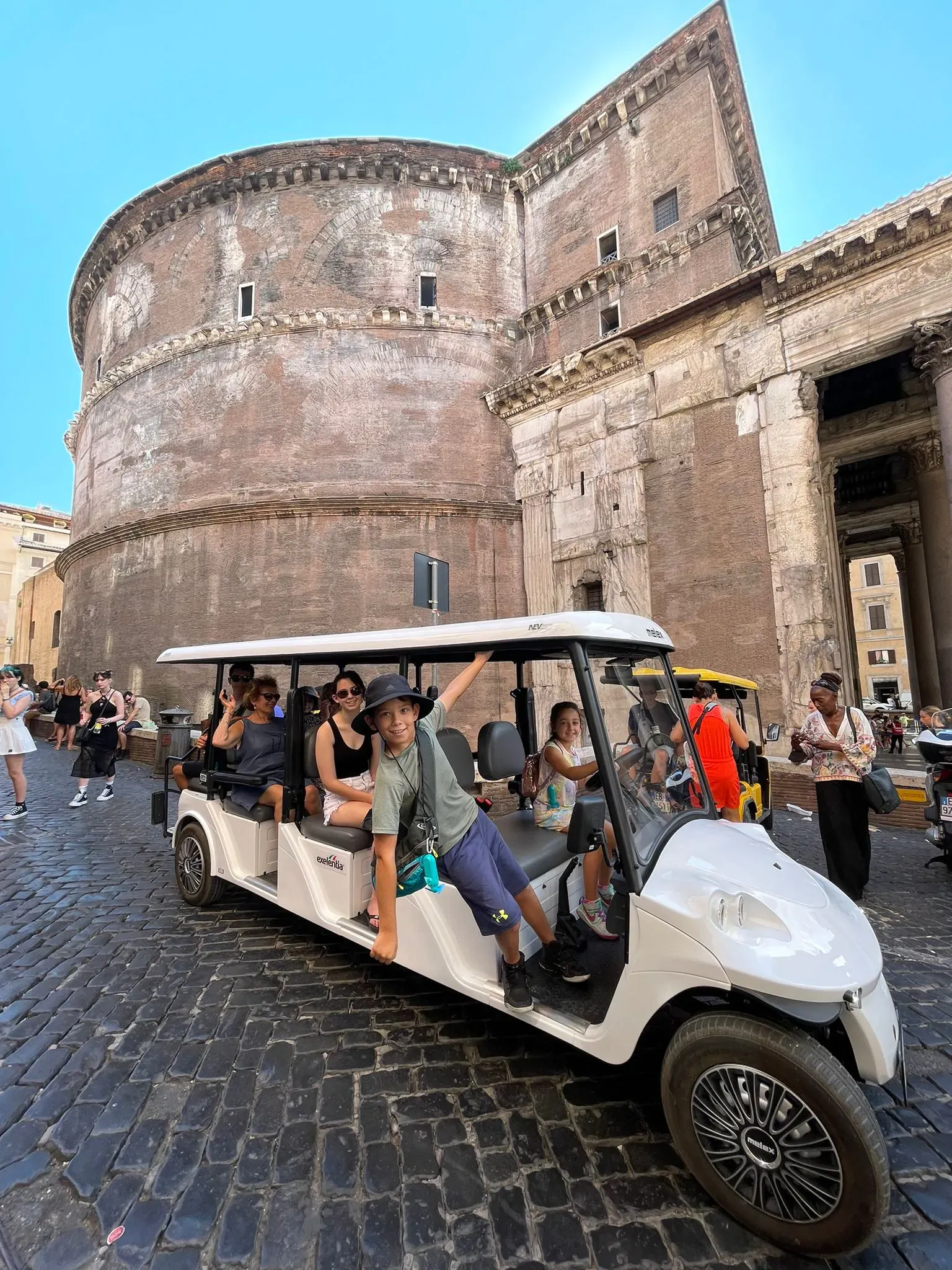
Although our Rome Golf Cart tour follows a tried-and-tested itinerary, upon special request it can be 100% customisable—so you can hone in on the attractions that interest you most.
Forget the fatigue of traipsing around the Eternal City. This tour saves you time and energy as you see all the capital’s must-see sites in half the time. Jump aboard your horseless chariot and let us chauffeur you around Rome in comfort and convenience. Enjoy exclusive access to traffic-limited areas, and enjoy hopping on and off your golf cart straight at the foot of your attraction of choice.
Visit the stunning Trevi Fountain, immortalized in Fellini’s classic film La Dolce Vita, and throw a coin over your shoulder to ensure your return to Rome! Admire the tumbling terraces and balustrades of the famous Spanish Steps, and discover what exactly it is that makes the monument Spanish!
Gaze up in awe at the Pantheon, Rome’s best-preserved ancient temple, and learn the fascinating history of how it was founded and how it has fared. Drive to the foot of Piazza Navona, Italy’s most stunning square, which was built above an ancient structure your guide will bring to life.
Your Rome Golf Cart tour takes you up the Aventine Hill, where Romulus’ brother Remus tried—but failed—to found his city. Pass by the Orange Garden, stopping off to enjoy its views, and check out the famous Keyhole View over Saint Peter’s Basilica and the Territory of the Order of the Knights of Malta.
Stop off at the famous Mouth of Truth situated right by the River Tiber in the area where Rome was founded. This stunning stretch of road around the most ancient part of the Eternal City also takes us past the Theatre of Marcellus (a building started by Julius Caesar and finished by the emperor Augustus) and the impressive Capitoline Hill.
You can choose where your tour finishes: in Rome’s centre, at your hotel, or wherever you want to explore next! If you’d like to visit the Colosseum, Castel Sant’Angelo or the Vatican on your Golf Cart Tour of Rome, we can also arrange for this, depending the time and location of your departure or finish point.
For all special requests, please contact us directly.
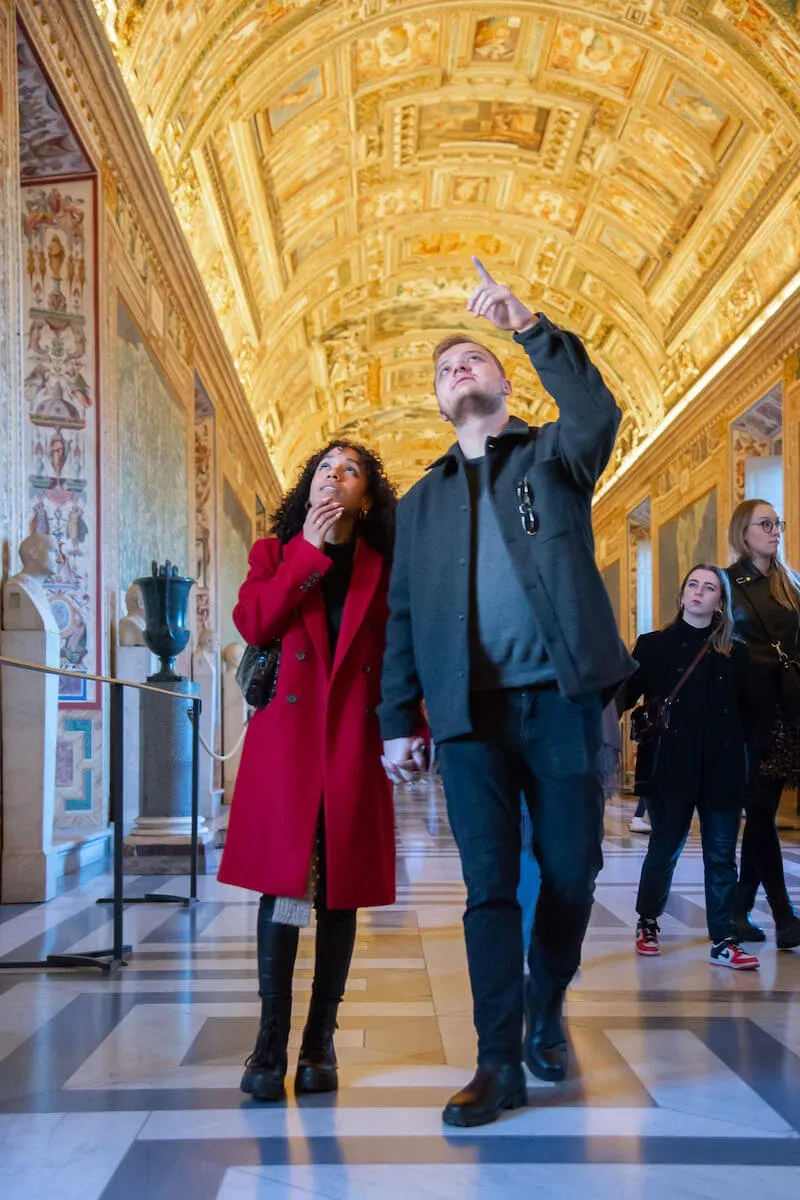
People made a pilgrimage from all over the world to visit the spiritual home of Catholicism. Unfortunately, this means that getting into the Vatican is by no means easy. With our priority entrance, you’ll be able to skip the hours of waiting in line and walk right into one of the most historically rich places in the world.
Your private tour starts with the Vatican Museums. Don’t be overwhelmed by the never-ending rooms or twisting corridors – we’ll guide you through some of the thousands of rooms without missing their deepest secrets. Our route includes the Hall of Maps, the Gallery of Tapestries, the Gallery of Candelabra, The Raphael Rooms and much more. Your friendly expert guide will be happy to answer any questions you might have.
After our trip through the museums, you’ll make your way into the Sistine Chapel, one of the most fabled historical sites in the world. The Sistine Chapel houses the timeless masterpiece crafted by none other than Michelangelo himself. Marvel at the Last Judgement in all its glory.
The pace of this private tour is comfortable and can be adapted to suit you. It also includes all ticket prices for the areas that we’ll be visiting during our trip. Book your spot now to make sure you don’t miss out on the chance to visit one of the most sacred spaces on Earth!

Tired of big-group tours that move from one attraction to the other before you’ve even had the chance to understand what your seeing?
This is the Vatican Tour for you.
Our VIP Vatican tour offers a more personal, intimate experience that doesn’t compromise on anything. See it all, learn it all, and feel it all.
With a maximum group size of 12, you can guarantee you’ll have more than enough time and privacy to soak up the stunning artworks and fascinating history of the Vatican City.
Our tour starts at the Vatican Museums, where more than four millennia’s rich history resides. Worried about getting lost in the labyrinth of corridors and galleries? Don’t be. Gain real-world insight into the stunning wonders of the museum’s 1000+ rooms thanks to the help of your friendly, expert guide. They’ll be excited to answer as many questions that you could possibly come up with, so feel free to ask away.
Afterwards, we’ll head over to the Pope’s private place of prayer, the Sistine Chapel. Home to two of Michelangelo’s masterpieces, The Last Judgement and its famous ceiling, the Sistine Chapel is just as awe-inspiring today as when it was unveiled in the 1500s. Marvel at world famous frescoes and discover how Popes are elected, here in this very room.
Our VIP Vatican tour runs at a comfortable, leisurely pace and includes all ticket prices for the different sites and areas we’ll be visiting. Remember, our VIP tours only accommodate a maximum of 12 people at a time, which means that spots fill up fast.
Book your VIP Vatican Tour now to avoid disappointment!
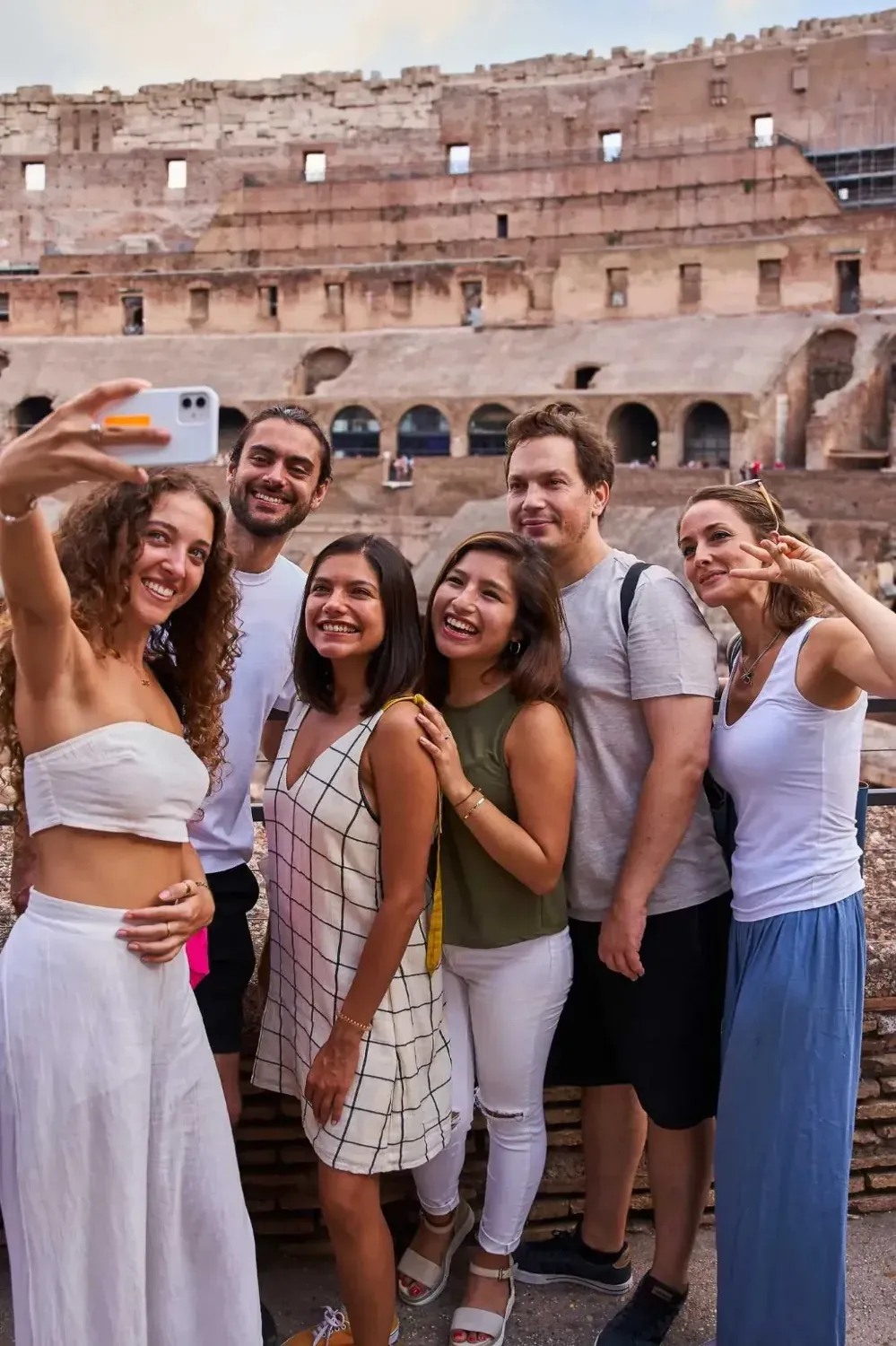
Go back in time on a once-in-a-lifetime, semi-private exploration of Ancient Rome’s most legendary landmarks—the Colosseum, Palatine Hill, and Roman Forum.
Designed for comfort and connection, this semi-private tour is limited to just 6 guests, giving you more one-on-one time with your expert guide, a relaxed pace, and the opportunity to dive deeper into the stories that fascinate you most.
With priority, fast-track access, you’ll also glide past the crowds and straight into the heart of the Eternal City. Save time, avoid the stress, and make the most of every moment with the people who matter most to you.
Your 3-hour journey begins inside the iconic Colosseum. We’ll take in the breathtaking views from above the arena that most visitors miss. Here, you’ll stand where gladiators once battled and hear captivating tales of emperors, epic contests, and ancient innovation. With fewer people in your group, your guide can personalise the experience, answering your most burning questions and focusing on what interests your group.
Next, we’ll ascend the legendary Palatine Hill, the mythical birthplace of Rome and site of the Empire’s most extravagant palaces. Then, descend into the Roman Forum, once the bustling centre of Roman public life. As you walk through the ruins of temples, arches, and political buildings, your guide will bring the ancient world to life.
This isn’t just a tour, it’s a meaningful journey into history, crafted for curious travellers seeking a deeper, more intimate Roman experience.
Prepare for a unique, unforgettable journey through Rome’s most famous landmarks with a small, friendly group that lets you explore at your own pace.
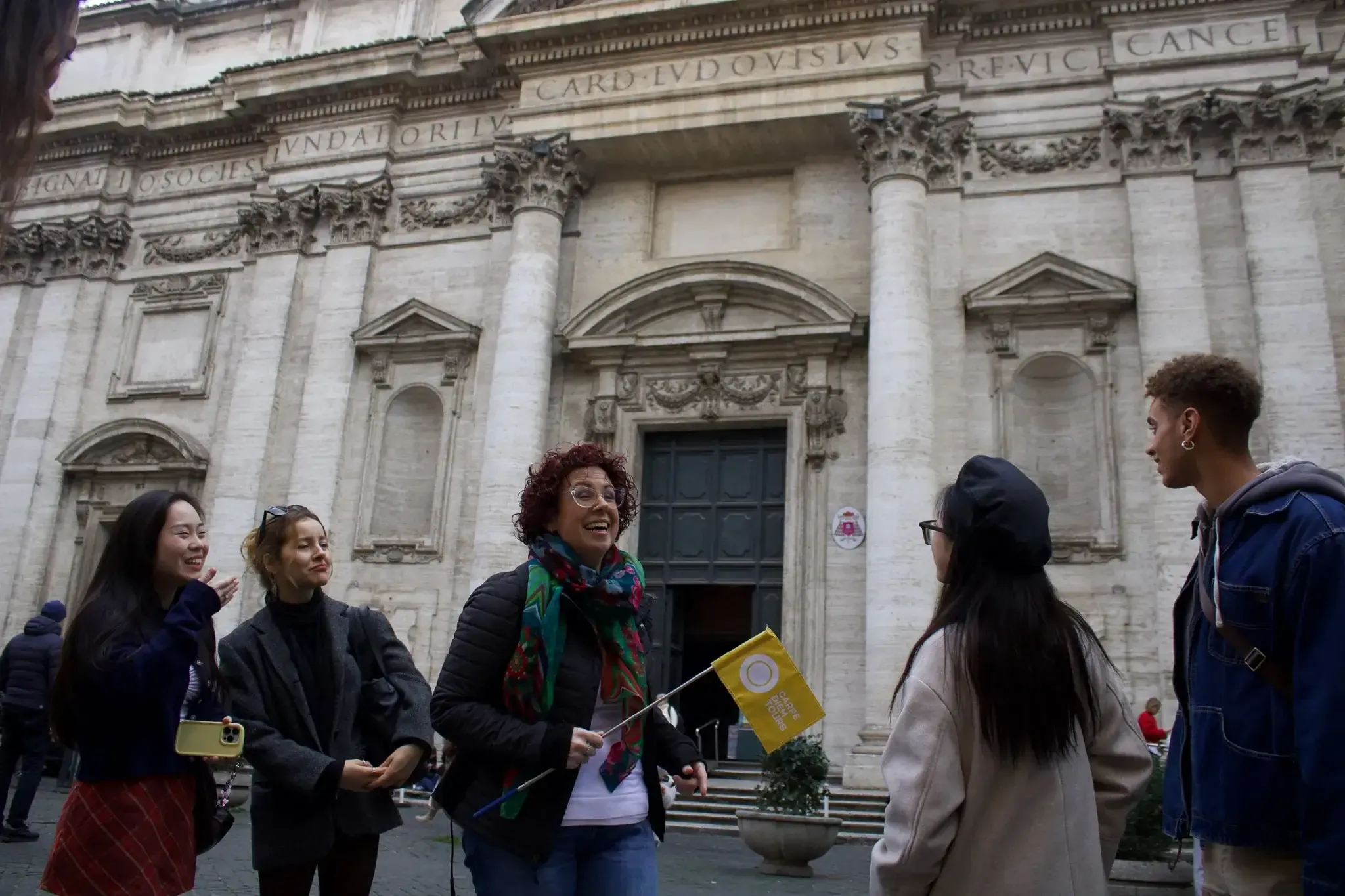
Explore the wonders of the Eternal City on our Wonders of Rome Walking Tour! As you get your bearings around Rome’s cobbled historic centre, your expert storyteller will bring Rome’s most must-see sites to life, including the Pantheon, Trevi Fountain, and Piazza Navona. Take photos, make memories, and most importantly, get the most out of your time in the Italian capital!
Your guide will share the city’s secrets and narrate its story in a way that will make you feel like you’ve stepped back in time – from explaining how the stunningly intricate churches and palaces were erected, to how the grand fountains were used to channel water throughout the city.
After meeting your guide at Piazza d'Aracoeli, we'll head to the Piazza Venezia, the crossroads between the ancient city and the modern capital and one of the most scenic squares in Italy! We'll then admire Trajan’s Column, a second-century AD monument which portrays the bloody victory of the emperor Trajan in his Dacian wars in Eastern Europe.
After taking a moment to marvel at the imposing Altar of the Fatherland, we’ll make our way to the iconic Trevi Fountain. Toss a coin into the fountain, spend a moment soaking in its sounds and scenery (metaphorically, not literally!), and uncover the fascinating stories behind the fountain’s statues and symbols.
We’ll then make our way to the Pantheon where the spectacle of the 2000-year-old dome will blow you away. Marvel at one of the best-preserved buildings of the ancient world, hear the story behind the man who built it, and discover the shocking architectural secret behind how the dome is (or isn’t) supported!
The square is situated near some of Rome’s best and most vibrant bars and restaurants and your guide will be happy to recommend where to go.
Our Rome Walking Tour is suitable for people of all ages and fitness levels. You can expect this memorable experience to last about two hours, which leaves you with more than enough time to explore the city beyond. Make sure you don’t miss out.
Secure your spot today!
